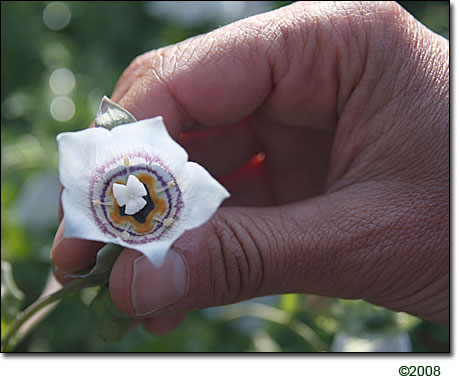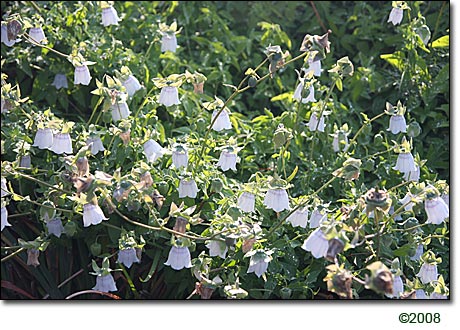Codonopsis clematidea
BONNET BELLFLOWER, ASIAN BELLFLOWER
Family: Campanulaceae
Pronounced: ko-don-OP-sis klem-ah-TID-ee-ah
Quick Jumps
Growing Guide
Rainy Side Notes
GROWING GUIDE

Origin:
Asia.
Plant Group:
Vines.
Hardiness:
Sunset zones: Not listed.
USDA zones: 7-9.
Heat zone: 9-7.
Mature size:
Height: 2-3 feet (60-90 cm).
Width: 2 feet (60 cm).
Flowering period:
June to July.
Flowering attributes:
Pale blue, nodding, 1-inch long by ½-inch wide, bell-shaped flowers with yellow, blue and purple markings inside.
Leaf attributes:
Pointed, alternate, narrow-ovate, pale gray-green leaves.
Light:
Full sun to light partial shade.
Soil:
Light, fertile, gritty, humus rich, moist, well-drained soil.
Feeding:
Mulch well with composted manure or compost. Fertilize once a month with a complete organic fertilizer during the growing season.
Propagation Methods:
Sow seed in autumn or spring.
Pests and Diseases:
Protect from slugs and snails.
Rainy Side Notes

This herbaceous perennial, commonly referred to as a vine, with its sprawling tendencies and 2 to 3 feet height, looks more like a perennial; however, it does twine like a vine. Endemic to the rocky mountain slopes of East Asia, the name Codonopsis comes from the Greek word kodon, meaning a bell and opsis, referring to the bell-shaped flower. Clematidea refers to its clematis-like flower. This is not surprising since the flower looks like a cross between a clematis and campanula.
Site this plant carefully; once these plants are established, they do not like their fleshy, tuberous roots to be disturbed. The best view of them would be on top of a wall, because looking up into the blossoms reveals the striking markings inside the nodding, pale-blue bells. This plant is highly fragrant when the leaves are crushed, but it's not the scent you want to be around, unless you enjoy the olfactive family of skunk eau de perfume.
In Uzbekistan, this plant is used along with other folk medicines to treat diseases such as jaundice, hepatitis and other liver diseases. Scientists found a new alkaloid along with 13 other compounds in the vine.
Photographed at Far Reaches Farm in Port Townsend, Washington.
A Pacific Northwest Plant of the Week (2011)

Gardening for the Homebrewer: Grow and Process Plants for Making Beer, Wine, Gruit, Cider, Perry, and More
By co-authors Debbie Teashon (Rainy Side Gardeners) and Wendy Tweton
Copyright Notice | Home | Search | Vines

